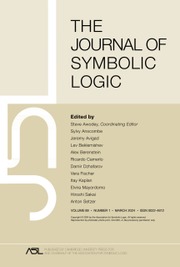No CrossRef data available.
Article contents
FORBIDDEN INDUCED SUBGRAPHS AND THE ŁOŚ–TARSKI THEOREM
Published online by Cambridge University Press: 04 January 2024
Abstract
Let  $\mathscr {C}$ be a class of finite and infinite graphs that is closed under induced subgraphs. The well-known Łoś–Tarski Theorem from classical model theory implies that
$\mathscr {C}$ be a class of finite and infinite graphs that is closed under induced subgraphs. The well-known Łoś–Tarski Theorem from classical model theory implies that  $\mathscr {C}$ is definable in first-order logic by a sentence
$\mathscr {C}$ is definable in first-order logic by a sentence  $\varphi $ if and only if
$\varphi $ if and only if  $\mathscr {C}$ has a finite set of forbidden induced finite subgraphs. This result provides a powerful tool to show nontrivial characterizations of graphs of small vertex cover, of bounded tree-depth, of bounded shrub-depth, etc. in terms of forbidden induced finite subgraphs. Furthermore, by the Completeness Theorem, we can compute from
$\mathscr {C}$ has a finite set of forbidden induced finite subgraphs. This result provides a powerful tool to show nontrivial characterizations of graphs of small vertex cover, of bounded tree-depth, of bounded shrub-depth, etc. in terms of forbidden induced finite subgraphs. Furthermore, by the Completeness Theorem, we can compute from  $\varphi $ the corresponding forbidden induced subgraphs. This machinery fails on finite graphs as shown by our results:
$\varphi $ the corresponding forbidden induced subgraphs. This machinery fails on finite graphs as shown by our results:
– There is a class
 $\mathscr {C}$ of finite graphs that is definable in first-order logic and closed under induced subgraphs but has no finite set of forbidden induced subgraphs.
$\mathscr {C}$ of finite graphs that is definable in first-order logic and closed under induced subgraphs but has no finite set of forbidden induced subgraphs.– Even if we only consider classes
 $\mathscr {C}$ of finite graphs that can be characterized by a finite set of forbidden induced subgraphs, such a characterization cannot be computed from a first-order sentence
$\mathscr {C}$ of finite graphs that can be characterized by a finite set of forbidden induced subgraphs, such a characterization cannot be computed from a first-order sentence  $\varphi $ that defines
$\varphi $ that defines  $\mathscr {C}$ and the size of the characterization cannot be bounded by
$\mathscr {C}$ and the size of the characterization cannot be bounded by  $f(|\varphi |)$ for any computable function f.
$f(|\varphi |)$ for any computable function f.
Besides their importance in graph theory, the above results also significantly strengthen similar known theorems for arbitrary structures.
MSC classification
- Type
- Article
- Information
- Copyright
- © The Author(s), 2024. Published by Cambridge University Press on behalf of The Association for Symbolic Logic



